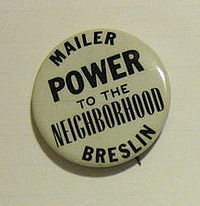The Faith of Graffiti
by Norman Mailer
thumb|Graffiti on New York subway car, 1973
thumb|New York City subway train covered in graffiti, 1973
thumb|Graffiti on a brick wall in Brooklyn, 1974
The Faith of Graffiti is a five-part essay. Each part moves from surface-level content like interviews with the graffiti artists to philosophical musings on art and politics.
In 'Part 1' of the essay, Mailer discusses the lives and inspirations of prominent graffiti artists. Mailer adopts the persona of the "Aesthetic Investigator", or A-I. To understand the motivations and drive of the graffitists, the A-I interviews four retired graffiti artists: CAY 161, JUNIOR 161, LI'L FLAME, and LURK. These graffitists strive to get their "names", how they are known as artists, in dangerous places "where people don't know how you could do it".
In 'Part 2', Mailer details the "existential stations of the criminal act" as graffitists prepare for their next "writing" by first "inventing", or stealing, paint.
'Part 3' describes the A-I's visit to the Museum of Modern Art for further insight into graffiti artists, and he sees graffiti as an “alluvial delta” of the river or art.
'Part 4' details the A-I's interview with the outgoing mayor of New York, John Lindsay. They examine Lindsay's view that graffiti was a "dirty shame" committed by "insecure cowards".
In 'Part 5', Mailer considers the various cultural and historical uses of art. He concludes that graffiti is perhaps the most germane expression of "the possible end of civilization": it "speaks of a new civilization where barbarism is stirring at the roots".
